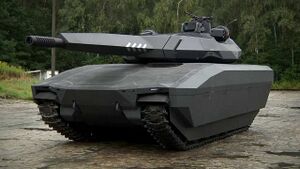KTP-190 Kardas
| Kardas | |
|---|---|
 A Kardas on display | |
| Type | Medium Tank |
| Place of origin | Silua |
| Production history | |
| Designer | Gavediene |
| Designed | 2008 |
| Manufacturer | Gavediene Joint Military Ordinance Corps |
| Produced | 2014 |
| No. built | ~1,500 |
| Specifications | |
| Weight | 30,000 kg (standard layout) 35,000 kg (with additional armour panels) |
| Length | 7 m |
| Width | 3.8 m |
| Height | 2.8 m |
| Crew | 3 |
Main armament | 120mm VG Industries compact smoothbore cannon |
Secondary armament | 1×7.62 mm machine gun |
| Engine | Diesel engine 1,200 hp turbocharged diesel engine |
| Suspension | Torsion bar |
Operational range | 500 km (on paved roads) 250 km (on rough terrain) |
| Speed | 85 km/h (53 mph) (on paved roads) 65 km/h (40 mph) (on rough terrain) |
Kardas is a Siluan medium tank designed by Gavediene, based on the Ruvelkan TSPJ1 Uhlan Light Tank light tank. The pre-production vehicle was first unveiled in 2013.
Design
The layout of the Kardas is similar to those of modern standard main battle tanks. The driver is located at the front of the vehicle's hull, with the commander and gunner also located in the hull and the unmanned turret mounted in the rear. In addition, there is a rear compartment in the hull which can accommodate four soldiers. The vehicle chassis is based on that of the TSPJ1 Uhlan Light Tank.
The vehicle armour has a modular ceramic-aramid shell, which is designed to provide protection compatible with NATO standard STANAG 4569 Annex A at level 5+ across the front portions of the hull and turret. Additional armour panels are mounted on the turret and hull, and are designed to provide full protection against a range of projectiles. The hull of the vehicle provides protection against improvised explosive devices (IEDs) and landmines in accordance with appendix B parts 4a and 4b of the STANAG 4569 standard. The entire vehicle is covered with radiation-absorbent material to create a Stealth ground vehicle.
The Kardas is equipped with a 1,200 horsepower (890 kW) turbocharged diesel engine coupled to a torque converter, automatic gearbox and driving assistance mechanism. The suspension is based on seven wheels, with the drive shafts having active damping of torsion bars mounted on the first and last two pairs. The vehicle can reach speeds of up to 85 kilometres per hour (53 mph) on paved roads and 65 kilometres per hour (40 mph) in rough terrain with a maximum range of 500 kilometres (310 mi). It can successfully climb an inclination of 30 degrees, cross ditches and trenches to a width of 2.6 metres (8 ft 6 in), and cross water obstacles with a depth of up to 1.5 metres (4 ft 11 in) without preparation, and up to 5 metres (16 ft) deep with preparation.
Weapons
The primary weapon of the Kardas is a 120mm cannon fitted within the unmanned turret. The cannon is be able to shoot both conventional projectiles and guided anti-tank missiles. It has an automatic loader for its main cannon, which ensures a fire rate of 6 shots per minute. The vehicle carries 45 rounds, 16 of which are stored within the turret and ready to fire, with the remainder stored within the chassis compartment. The tank is also armed with a 7.62mm machine gun with an ammunition supply of 1,000 rounds.
Additional equipment can be installed in a remote-controlled module. Planned designs included a 7.62mm machine gun; or 15.5mm machine gun; or a 40mm automatic grenade launcher with a supply of 8,000 rounds of 7.62mm, 400 rounds of 15.5mm or 96 rounds of 40mm grenades. Also built into the turret is an active protection system which intercepts incoming missiles, and smoke grenade launchers.
All equipment is electronically stabilized, and observation and sighting systems come with laser rangefinders, day-night cameras and third generation thermal imaging, with visual data displayed on a screen.
Equipment
The Kardas is fitted with a fire extinguishing system in the turret and hull, internal radio communication system, active anti-projectile protection system, battlefield management system, cooling exhaust system, thermal masking system, and air conditioning filters. The crew are provided with special seats to minimize the physical effects of nearby explosions. In addition, the vehicle is equipped with a satellite navigation system and friend-foe identification system.
Variants
In addition to its direct fire support role, the vehicle can also be configured as a command vehicle, mine clearance vehicle, or for armored vehicle repair.